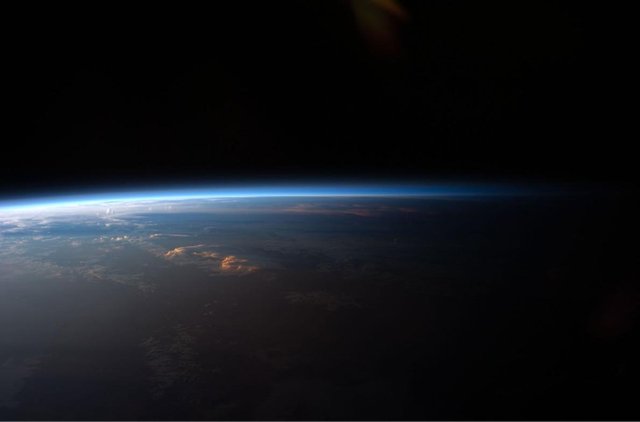From gases in the atmosphere to satellites in space, Earth is sending plenty of signals that something here is alive.As the universe's only known harbor for life, Earth is arguably one strange rock. But light-years from our solar system, other intelligent beings on a similar planetary oasis might be gazing in our direction and seeing us as a sign that they're not alone in the universe.
To date, astronomers have confirmed the existence of nearly 4,000 planets beyond our solar system, including some that just might have the conditions necessary to support life as we know it. As our technology improves, we should be able to learn more about these worlds and their chances of hosting plants, animals, and maybe even civilizations.
That means if aliens are out there, they could just as easily discover us.
First, they'd need to find Earth from afar, either by watching our sun wobble as the planet's gravity tugs against it, or by seeing the sun dim as Earth blocks a tiny fraction of sunlight during its orbit. Nine known alien worlds can see Earth transit across our sun, just as we've seen thousands of alien planets dim their host stars.
Once spotted, our planet would likely intrigue E.T. Our sun is relatively stable, not prone to disastrous flares that'd rip our atmosphere to shreds. What's more, we fall squarely within our sun's habitable zone, the area around a star where liquid water can persist on a planet's surface. (These are just some of the things that make life as we know it possible on Earth.)
Faraway scientists might then attempt to spot our atmosphere, to see whether life's thumb is on the chemical scales. But what would they be looking for? And could they really infer life's presence across trillions of miles?
Life Is Pretty Gassy
If you're afraid of alerting aliens to your presence, that ship sailed more than two billion years ago. Our planet's abundant oxygen is a major hint that something here is alive.
Oxygen is a highly reactive element, glomming on to other atoms and molecules with such alacrity that it's tough to find it in abundance by itself—unless something is breaking down oxygen-rich compounds and pumping out loads of O2. On Earth, you can thank photosynthetic plants for being generous oxygen factories.
But oxygen alone wouldn't be enough for E.T. to prove our existence. “We have discovered several ways in which O2 can accumulate in the absence of life,” says Stephanie Olson, an astrobiologist at the University of California, Riverside. “High levels of O2, or the processes culminating in high levels of O2, may actually preclude the emergence of life on some planets.”
In addition to oxygen molecules, alien astronomers would look at our atmosphere's levels of nitrogen, carbon dioxide, nitrous oxide, and methane. Only life could keep Earth chemically off-kilter enough for all these gases to persist at once.
Terra Cognita?
Beyond those chemical clues, alien astronomers with truly massive telescopes might even be able to map Earth's surface from afar, down to major urban areas.
In a paper published on the arXiv in 2017, astronomers Svetlana Berdyugina and Jeff Kuhnoutlined how astronomers could actually map the surfaces of alien planets from light-years away. To pull off such extreme cartography, they'd need a telescope at least 130 feet wide, custom-built for only one task: seeing the faint glow of light reflected off an alien planet. Variations in this reflected light over time would connote regional differences in the planet's terrain
As a proof-of-concept for this telescope, called the ExoLife Finder, or ELF, Berdyugina and Kuhn simulated how nearby aliens using the telescope would see Earth. From 25 trillion miles away, E.T. could not only map Earth's continents, but they'd also be able to see signs of intelligent life.
“The ELF telescope has the sensitivity to see a Los Angeles basin,” says Kuhn. “We don't see the lights, but we see the heat signature.” Their group, the Planets Foundation, is now building a single-mirror telescope in Hawaii to test the underlying tech. If all goes to plan, they say it's possible to build ELF within a decade.
It would be like Star Trek, the reality show,” says Berdyugina. “We could virtually visit these planets.”
Advanced Intelligence
If intelligent life is nearby, the most straightforward way to find earthlings would be to listen for us. For the last century, human civilization has been broadcasting its existence to the cosmos via our leaky radio transmissions. Occasionally, we've broadcast messages to E.T. intentionally, and sent golden records into the void on the off-chance that aliens stumble across our interplanetary spacecraft.
Aliens wouldn't be able to detect our radio presence, much less our golden records, unless they're within 590 trillion miles of Earth. If intelligent life is any farther away than that, our earliest radio signals simply haven't reached them yet.
The sun sets over South America, as seen by astronauts on board the International Space Station.
PHOTOGRAPH BY NASA
But in several centuries' time, intelligent aliens may see other signs of our tech-savviness. In a study recently accepted to The Astrophysical Journal, for example, astrophysicist Hector Socas-Navarro says we could find intelligent life by looking for artificial satellites orbiting alien worlds. And that means they could find us using similar methods.
As a satellite-fringed world drifts in front of its home star, its satellites would block some starlight in front of and behind the transiting planet. This metallic belt would look unnatural when compared to known planetary rings.
Currently, Earth's satellite network isn't anywhere near dense enough to be detected, nor will it be anytime soon. But our footprint in space is growing exponentially: If we keep launching satellites at our present pace, Socas-Navarro says in his study, nearby aliens armed with telescopes as powerful as the ones we have today could spot our satellites by 2200.
Winds of Change
Of course, Earth is more than 4.5 billion years old, and life has changed a lot over the eons. What if alien astronomers had looked our way even a billion years ago?
In a 2018 paper in Science Advances, Olson and her colleagues simulated how Earth's atmosphere has changed over time. Even three billion years ago, aliens may have been able to infer life by sniffing out methane and carbon dioxide in the early atmosphere. But our modern atmosphere—a literal beacon for life—arrived only about 500 million years ago.
“For more than a billion years of Earth history, an alien astronomer may have even been sufficiently misled to conclude that Earth was sterile—despite the fact that life was flourishing in our ocean at the time,” says Olson.
Still, if the aliens were advanced and committed enough, even an early Earth would yield compelling clues for life, says study coauthor Joshua Krissansen-Totton of the University of Washington.
“The presence of life on Earth has been fairly obvious for the last 4 billion years to anyone who could build a big telescope,” he says in an email. “If there was anything nasty out there, then they would have extinguished life on Earth long ago. I think we are safe inviting them over to visit and exchange notes on the cosmos.”
If aliens are anything like us, perhaps the news that they aren't alone in the cosmos wouldn't be their equivalent of earth-shattering. In a study published in Frontiers in Psychology in February, researchers found that people, at least, would take the discovery of alien life in stride.
.jpeg)


Hi! I am a robot. I just upvoted you! I found similar content that readers might be interested in:
https://news.nationalgeographic.com/2018/03/how-aliens-could-discover-life-on-earth-one-strange-rock-science/
Downvoting a post can decrease pending rewards and make it less visible. Common reasons:
Submit
Oo really. Thank you so much for supporting and voting..
Downvoting a post can decrease pending rewards and make it less visible. Common reasons:
Submit
Congratulations @vikas364704! You received a personal award!
You can view your badges on your Steem Board and compare to others on the Steem Ranking
Do not miss the last post from @steemitboard:
Vote for @Steemitboard as a witness to get one more award and increased upvotes!
Downvoting a post can decrease pending rewards and make it less visible. Common reasons:
Submit